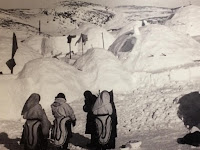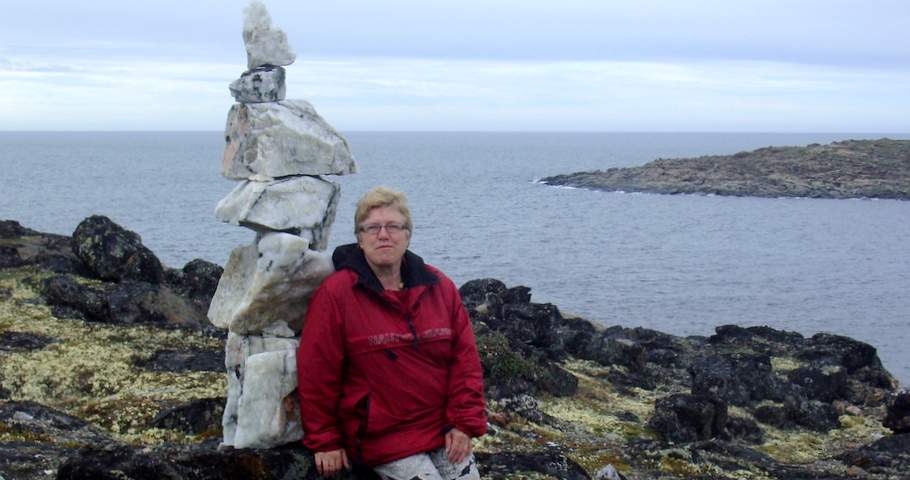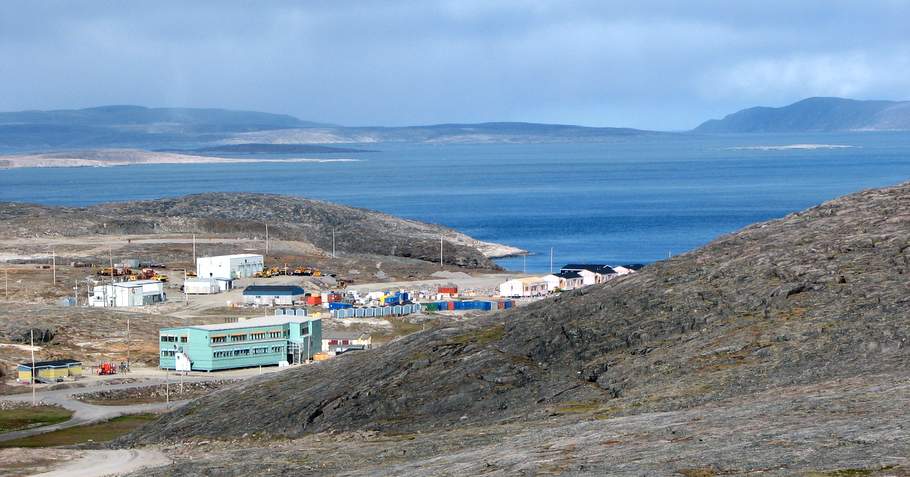Friday, December 23, 2016
The perspective of potentially ruining a child’s outcomes claims my commitment
The point I want to make here is that the perspective of potentially ruining a child’s outcomes claimed my commitment when I was working up North in Nunavik, Quebec, Canada.
It was the hardest work I have ever had to do and you have to have done it to say something like: "On Monday mornings, I put myself in button-responsive mode and I will reflect on what I have done when I leave here for good" (my co-worker's words to me when I complained about never being allowed by supervisor to think things through for the best of the people and the children). No Child Should Take the Long Way Home aims to reduce the number of placements children have to face in Nunavik.
Saturday, October 29, 2016
The assumption that Indigenous people can move on shines light on our heartlessness
Before anyone judges the Inuit of Nunavik, Quebec, Canada, it is important to understand the history behind the issues. We must remember that, as North Americans, our collective ancestry decimated their populations with violence and new diseases.
The turmoil and anguish they had to go through are evident. Yet, they are still not provided the same opportunities we have even though they were "Canadian" even before we were.
The turmoil and anguish they had to go through are evident. Yet, they are still not provided the same opportunities we have even though they were "Canadian" even before we were.
Tuesday, October 18, 2016
Self-perpetuating systems ensure the failure of families
On Thanksgiving, there were more Indigenous children in Canada sitting at stranger's tables timidly eating someone's turkey instead of sharing a special time with their own family, be they aunties, uncles and/or grandparents. Canada’s colonial practice of forcibly removing Indigenous children from their families did not end with the closing of Indian residential schools. It continues today in the form of provincial and territorial child welfare systems, which remove Indigenous children and youth at alarmingly high rates.
No Child Should Take the Long Way Home seeks solutions that have been tried by other Canadians to keep apprehended children close to their communities as an alternative to flying them out thousands of kilometers away.
The Honourable Carolyn Bennett, M.D., P.C., M.P., Minister of Indigenous and Northern Affairs says it very well: ''Children are our future, and to give them the best possible start in life, we must collectively move from an intervention-based approach of apprehension and protection to prevention-based approaches to community, families and children's rights and well-being. Working in genuine partnership with First Nations is critical to developing community-led solutions for reform that will reduce the number of children in care and result in better health, education and economic outcomes.''
No Child Should Take the Long Way Home seeks solutions that have been tried by other Canadians to keep apprehended children close to their communities as an alternative to flying them out thousands of kilometers away.
The Honourable Carolyn Bennett, M.D., P.C., M.P., Minister of Indigenous and Northern Affairs says it very well: ''Children are our future, and to give them the best possible start in life, we must collectively move from an intervention-based approach of apprehension and protection to prevention-based approaches to community, families and children's rights and well-being. Working in genuine partnership with First Nations is critical to developing community-led solutions for reform that will reduce the number of children in care and result in better health, education and economic outcomes.''
Thursday, September 22, 2016
Children are issues of concern for all citizens of Canada
Why are there still more First Nations children in care right now than at the height of the residential school system?
Instead of being at home with their parents, brothers, and sisters, tens of thousands of First Nations children are in foster care, staying with distant relatives or living in institutions.
Instead of being at home with their parents, brothers, and sisters, tens of thousands of First Nations children are in foster care, staying with distant relatives or living in institutions.
Labels:
Canada,
children,
family law,
foster care,
housing,
Inuit,
mother-blaming culture,
mothers,
No Child Should Take the Long Way Home,
notion of risk,
overcrowding,
petition,
residential schools,
safety
Tuesday, August 23, 2016
The outcome of intercultural placement carries the seeds of alienation from self
Policies and practices reflect longstanding and deeply embedded mother-blaming culture and father invisibility ideologies that shape child protection systems. With regard to children in this year of reconciliation, one has to believe another solution is possible, that whatever solution brought about does not stem from ideology, that big changes are going to happen in this lifetime. Children need to be safe, but they also need to be among their people.
Thursday, August 18, 2016
Everything is changing-the future needs re-arranging
Transcultural placements of Inuit children are more complex than what seems to meet the eye. Children are often placed in non-Inuit families for years and sometimes never return home.
Policies and practices reflect longstanding and deeply embedded mother-blaming culture and father invisibility ideologies that shape child protection systems. This misuse of power attests to our colonization past when it comes to this isolated population.
Policies and practices reflect longstanding and deeply embedded mother-blaming culture and father invisibility ideologies that shape child protection systems. This misuse of power attests to our colonization past when it comes to this isolated population.
Thursday, July 21, 2016
Moving Together to Have the Stories of the Inuit Heard
Tuesday, July 12, 2016
A need to focus on girls’ voices, concerns and realities
Violence is a reality for many girls in Canada. There is a need to focus on girls’ voices, concerns, and realities. Physical abuse against children is rarely publicized since they do not have a VOICE.
For example, when an Inuit girl child showed me the marks of physical abuse, I was told not to vent it out it, otherwise, her family would know we were after them and might beat her worse. For men, it is often their inability to provide their families with basic needs and their demands for certain foods, clothes, etc. For women, it is the burden of responsibilities at home and the lack of space and support.
For example, when an Inuit girl child showed me the marks of physical abuse, I was told not to vent it out it, otherwise, her family would know we were after them and might beat her worse. For men, it is often their inability to provide their families with basic needs and their demands for certain foods, clothes, etc. For women, it is the burden of responsibilities at home and the lack of space and support.
Sunday, July 3, 2016
My knowledge keeps me on the path
As you can tell, I will never be Inuit. But when I worked among them, I learned a lot from them.
Unfortunately, in line of my work in protection, I was confronted with a structure that had too much red tape bringing with it many walls for the Inuit women and so much oversight that women did not get the benefits of justice.
Unfortunately, in line of my work in protection, I was confronted with a structure that had too much red tape bringing with it many walls for the Inuit women and so much oversight that women did not get the benefits of justice.
Friday, June 10, 2016
Walking bends your mind
My plan is to continue walking from West toward Victoria County, NB. I started in April 2016 to share my Nunavik experience with Canadians and raise money for a safe house-haven for children to remain in their Northern communities.
Sunday, May 29, 2016
The spiritual meaning of truth and reconciliation for the tribes
I’m waiting to get walking again. Some people react to the fact that I’m not walking constantly. I get questions like “Aren’t you going to be late in your walk of 8000 kilometers"? What is your agenda? If you’re not walking, what is the sense"?
Wednesday, May 18, 2016
Major stresses in the Northern households are responsible for social problems
 Although dozens of isolated indigenous communities in Canada have recently declared states of emergency due to suicide epidemics, unclean water, and a lack of adequate infrastructure, there is not yet into a common commitment to further the voice, the rights, and dignity of children.
Although dozens of isolated indigenous communities in Canada have recently declared states of emergency due to suicide epidemics, unclean water, and a lack of adequate infrastructure, there is not yet into a common commitment to further the voice, the rights, and dignity of children.Saturday, May 7, 2016
There are unsung heroes among the Inuit women
There are unsung heroes among the Inuit women
As I watched my good friend Annie, I remember thinking there were unsung heroes among them. More than half of the women were grandmothers. None had white hair; they seem to have retained a full head of dark hair in spite of their age.Tuesday, May 3, 2016
In our rich country, 80% of food bank users are children
 When I decided to start walking from Victoria BC, I was not anticipating my learning curve regarding poverty. As a mother, as an engaged citizen and as a walker with a mission to walk and talk, I was only aware that I needed to bring attention to critical issues facing the children of Nunavik.
When I decided to start walking from Victoria BC, I was not anticipating my learning curve regarding poverty. As a mother, as an engaged citizen and as a walker with a mission to walk and talk, I was only aware that I needed to bring attention to critical issues facing the children of Nunavik.My purpose is to empower women and children on their rights, about
their options and what it takes to actually make a difference.
From my meeting with Mayor Helps, it is an understatement to say that housing is a Canadian concern.
Although she did state that BC was in a good position to build social housing conditional upon the other half of the money coming from another source (CRD), my heart was skipping a beat thinking about the people of the North. In the case of BC, there is to be an announcement soon.
Monday, April 25, 2016
The story from here-THE CHILDREN NEED A VOICE
 If there is one justice in this world, my project qualifies as one seeking justice. It has everything to do with life and about making sure we bring to others a strong sense of justice and the power of faith to achieve it.
If there is one justice in this world, my project qualifies as one seeking justice. It has everything to do with life and about making sure we bring to others a strong sense of justice and the power of faith to achieve it.Saturday, April 16, 2016
Into a new stage of the project: my purpose
What is my purpose, you might ask?
When I went to work up North, I really thought I could make a DIFFERENCE but it became soon apparent that I was hitting upon walls I had not expected. Over and over, I was told I did not have judgment, not enough experience of the North and that I just didn’t understand. I was always left alone with my questions. It wasn't until I read Catherine Richardson's book that I fully understood what I had seen, heard and felt.
So it became apparent that I could not, just sit there and watch it happen. Thereby, my walk and my purpose evolved as I made plans to go across Canada, not only to inform but also to raise funds for safehouses so that the children can stay safe and remain in their communities.
When I went to work up North, I really thought I could make a DIFFERENCE but it became soon apparent that I was hitting upon walls I had not expected. Over and over, I was told I did not have judgment, not enough experience of the North and that I just didn’t understand. I was always left alone with my questions. It wasn't until I read Catherine Richardson's book that I fully understood what I had seen, heard and felt.
So it became apparent that I could not, just sit there and watch it happen. Thereby, my walk and my purpose evolved as I made plans to go across Canada, not only to inform but also to raise funds for safehouses so that the children can stay safe and remain in their communities.
Friday, April 1, 2016
Bridge the differences and build connections
 Inuit are at or near the bottom of all indicators of core socio-economic well-being. The oppression has led Inuit people to lose contact with their culture and identity. But, despite the hardship and adversity in power, with a failing of the justice system, the importance of the family in the social, economic and political of the people highlights their ability to work TOGETHER to find relevant solutions for themselves. Such approaches, mobilizing all resources, provide steps that redefine culturally appropriate processes for the people.
Inuit are at or near the bottom of all indicators of core socio-economic well-being. The oppression has led Inuit people to lose contact with their culture and identity. But, despite the hardship and adversity in power, with a failing of the justice system, the importance of the family in the social, economic and political of the people highlights their ability to work TOGETHER to find relevant solutions for themselves. Such approaches, mobilizing all resources, provide steps that redefine culturally appropriate processes for the people.Tuesday, March 22, 2016
The effects of settlement on the living conditions of Indigenous and Inuit people
 The patience of the Inuit could pass for passivity but behind their serene equanimity hides a resilient people, of a curious and enterprising nature. They are patient and not passive. Arctic populations are somewhat in the image of their environment. Behind their nonchalant affability, they are exotic, adventurous, formidable survivors with an unusual inner strength in an adverse environment.
The patience of the Inuit could pass for passivity but behind their serene equanimity hides a resilient people, of a curious and enterprising nature. They are patient and not passive. Arctic populations are somewhat in the image of their environment. Behind their nonchalant affability, they are exotic, adventurous, formidable survivors with an unusual inner strength in an adverse environment.
Labels:
Arctic,
Canada,
communities,
families,
Inuit,
petition,
poverty,
solidarity,
toundra
Friday, March 11, 2016
The solidarity of women in favor of profound changes is already underway
Despite the magnitude of the task, despite the appearance of what some call a waterproof wall, despite the dominant discourse that says that the Inuit accept their destiny, we must reject the attitude of "giving up" that there is nothing to do but wait.
Rather, the problems have been identified, measures to redress the situation in depth are being felt.
Rather, the problems have been identified, measures to redress the situation in depth are being felt.
Monday, March 7, 2016
The complexity of the history of the indigenous people remains the distinctive feature they share
The day when hopes and gestures offer a more equitable development in remote areas, we will imagine that all children will no longer be condemned to live "social suffering". The historical processes of colonization, marginalization and coercive assimilation have contributed to poverty and the ensuing hardships. In my viewpoint, it is a violation of human rights. How can we build self-sufficient communities with the systems in place, the ones that keep the people down.
Friday, February 26, 2016
To communicate the little-known reality of the Inuit
 To begin, all the previous texts were to serve to communicate the little-known reality of the Inuit people through their conditions of life. During my research, I realized that the history of many indigenous peoples were alike. The texts thus became more general, however, keeping in mind the real distinctions of far-away communities living away from one another affected by very similar problems. An example of these differences relates to Inuit communities. No roads, no judges, no equal opportunities for employment, but with the same tax obligations as all other Quebecers. Their nordicity is not served very well in Nunavik: racism and discrimination don't set the tone for human rights.
To begin, all the previous texts were to serve to communicate the little-known reality of the Inuit people through their conditions of life. During my research, I realized that the history of many indigenous peoples were alike. The texts thus became more general, however, keeping in mind the real distinctions of far-away communities living away from one another affected by very similar problems. An example of these differences relates to Inuit communities. No roads, no judges, no equal opportunities for employment, but with the same tax obligations as all other Quebecers. Their nordicity is not served very well in Nunavik: racism and discrimination don't set the tone for human rights.Wednesday, February 10, 2016
Housing in Nunavik affects all aspects of an individual's life
 While "overcrowding" is both a cause and an effect, it is still possible to delineate the main causes of overcrowding in Nunavik. This has a ripple effect on all the members of the household, including the children: stress, incest, the inability of children to study because there is no privacy, beating of wives and children, quarreling and yelling.
While "overcrowding" is both a cause and an effect, it is still possible to delineate the main causes of overcrowding in Nunavik. This has a ripple effect on all the members of the household, including the children: stress, incest, the inability of children to study because there is no privacy, beating of wives and children, quarreling and yelling.Friday, January 22, 2016
Looking to the future, a priority on everyone's doorstep
How do they think they will organize community efforts to build resilient families and individuals?
How do they think they will teach non-violence and components of healthy relationships while developing codes of conduct that promote respect and strengthen non-violence?
How will they deal with poverty, food shortage, violence, suicide and generalized gender inequalities serving as prerequisites for trafficking in women and how will they protect their girls?
How will find the resources to ensure the children are safe?
Subscribe to:
Posts (Atom)



















